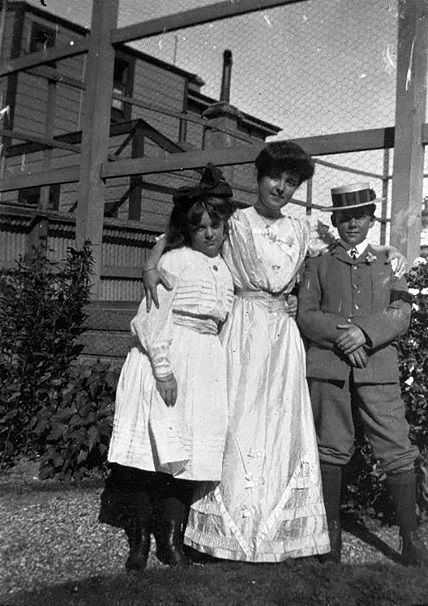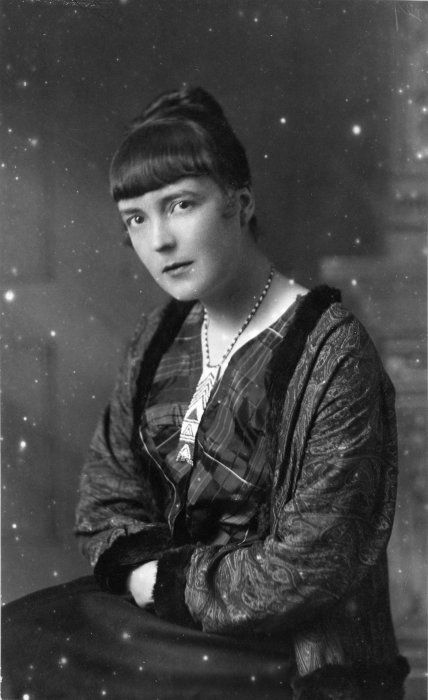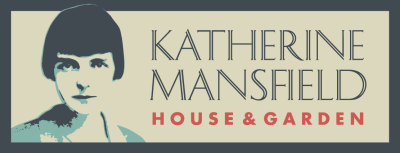KATHERINE MANSFIELD - FASHIONISTA
- 5 August 2015
- Nicola Saker
Katherine Mansfield loved clothes. She loved them as much as she loved flowers (read this blog post to find out how much!)
Flowers do not last, and often nor do clothes – they are usually amongst the perishable pieces of a life. But Mansfield’s mercurial personality and style were clearly so arresting that we have many descriptions of her clothes.

Image: Katherine Mansfield in 1907 with her sister Jeanne and brother Leslie, possibly in the garden of their home on Fitzherbert Terrace, Thorndon. Courtesy of the Alexander Turnbull Library, 1/2-011986-F.
These begin early, just after the turn of the twentieth century, when she and her sisters were at the epicentre of fashionable Wellington and the local press covered their social circle’s events and couture. We glean that Katherine appeared at a ‘girls’ tea’ resplendent in mauve taffeta; at the Wellington College Sports she is glimpsed in "green shantung with green hat" and for her mother’s ‘At Home’ she wears "a dress of ecru lace with narrow pipings of flame-coloured silk." Yet another reference is to a blue chine silk patterned with pink rosebuds that was worn to a ball at the Star Boating Club.
When she left Wellington for the last time in 1907 and headed for London, a garden party was given for her departure by Lady Ward, the Prime Minister’s wife: "Miss K. Beauchamp wore a dark brown coat skirt, and black fox furs."
London was not only literature, writers, Modernism and the avant-garde – it was also Harrods, Harvey Nichols and the boutiques of Bond Street.
When she first landed there she stayed at Beauchamp Lodge (no connection with her family), a hostel for young, aspiring female singers and musicians. It was from there that she made her brief marriage to George Bowden, which meant she had to leave the lodge. A fellow student, Margaret Wishart, recalled: "she appeared as cool as a cucumber in a pink-and-white striped blouse and a brown tweed skirt and announced that she had been married."
We know Mansfield used clothes as costume and identity changes. When she and George Bowden were becoming acquainted, he mentioned her appearing in ‘Maori’ costume and also, intriguingly, being dressed in the manner of Oscar Wilde.
Her first meeting with John Middleton Murry, who was (eventually) to become her second husband, was at a dinner party given by Willy George: "She wore a simple dove-grey evening frock, with a single red flower and a grey gauze scarf."
In between these relationships, Mansfield lived on Cheyne Walk in Chelsea. The Japan-British exhibition held in London in 1910 had a profound effect and that she absorbed its aesthetic is evident in a friend’s description of her in the flat: "a couple of candles stuck in a skull, another between the high windows, a lamp on the floor shining though yellow chrysanthemums, and herself accurately in the centre, in a patterned pink kimono and white flowered frock, the one cluster of primary brightness in the room."

Image: Katherine Mansfield, c.1913. Courtesy of the Alexander Turnbull Library, MSX-4147-65.
In Chelsea she found a clever, but cheap dressmaker. She put together a basic wardrobe of black and white (her fondness for this combination lead editor Arthur Orage to call her ‘the marmozet’) that she could interchange, giving the impression of a larger wardrobe than she really possessed. She added colour with taffeta waistcoats, velvet jackets in vivid purples, reds and blues, and brightly coloured striped French stockings.
In a journal entry from this time, Mansfield wrote: “Quite impersonally I admired my silver stockings bound beneath the knee with spiked ribbons, my yellow suede shoes fringed with white fur. How vicious I looked!”
Anne Estelle Rice, who painted the famous portrait of Mansfield in a red dress, described Mansfield’s chameleon-like use of clothes in Paris in 1912. One night she would be a femme fatale in long black dress with a sequin scarf around her head, another as "Katoushka in a Russian peasant’s costume of brilliant colour" and memorably once appeared in a black cloak and a black turban with a white fez on top.
In her copious correspondence with Ida Baker, she often asked her to find fabrics, patterns and dressmakers:
The green skirt never came. I should indeed have liked it. Nor did the coat and skirt. I am all coats and no skirts – most awkward…
I do want one other thing. A perfectly plain chemise frock to wear without a petticoat to do exercises in the evening. You know the kind of thing. Cashmere would do – I mean a thin gabardine or something like that – dead simple, though & preferably dark blue with as little lining as possible. But it mustn’t show one’s legs through. Shall I send you 500 francs? [2 November 1922, Le Prieuré, Fontainbleau]
This was happening right up until her death at La Prieuré, and even there, unwell and soon to die, one of her room mates, Olgivanna (later Mrs Frank Lloyd Wright) describes her: "She sat in a comfortable chair near the big fireplace. She always dressed simply, beautifully, with some little touch of colour…”
